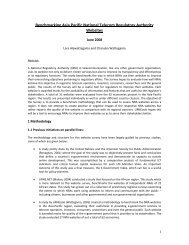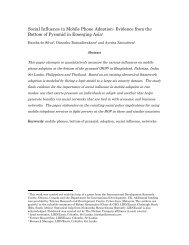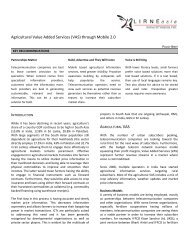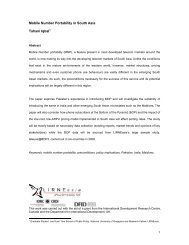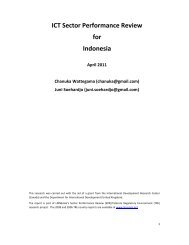Teleuse@BOP3: A Qualitative Study - LIRNEasia
Teleuse@BOP3: A Qualitative Study - LIRNEasia
Teleuse@BOP3: A Qualitative Study - LIRNEasia
You also want an ePaper? Increase the reach of your titles
YUMPU automatically turns print PDFs into web optimized ePapers that Google loves.
households. Such class leveler argument is, however, not mentioned in India or Sri Lanka, where it seems, all<br />
respondents and especially, the men have a very matter of fact attitude towards ownership. The perception in these<br />
2 countries is that mobile phones help people remain in greater connectivity and facilitate work but it has not<br />
fundamentally changed who they are as individuals and their respective positions in society.<br />
The pride associated with phone ownership, seems to be particularly high as seen in the urban male group<br />
discussions in Pakistan and Bangladesh. This results in misleading perceptions around ownership in both the<br />
countries but is striking in Bangladesh in particular. In Bangladesh, in the urban male group discussion group, more<br />
than 50% of the respondents seem to make very strong claims about having a phone since 2002. It is only after<br />
repeated confirmation seeking that it emerges that while they have used a mobile first around 2002; their individual<br />
ownerships are mostly in the horizon of two years. The most recent owners have had their own phones for 10<br />
months to a year.<br />
In contrast, when it comes to mobile ownership among female respondents, in India, Pakistan and Bangladesh, the<br />
female respondents, especially housewives, seem to have a difficulty in perceiving the phone as theirs although they<br />
may have received it from their husbands or brothers almost up to two years back. The women see these phones<br />
variably as a phone for the house or their husbands’ first phone but not as their own. This is largely because of the<br />
way in which the phones have come to them.<br />
In the case of most housewives, we see that they have had very little say in the choice, purchase or transitioning of<br />
the phone as opposed to the South East Asian countries. As pointed out by several female respondents in these<br />
countries, while the younger wives have been taken to mobile shops to see various models, the older wives have<br />
simply been given a phone that their husbands chose to purchase keeping in mind their understandings of what their<br />
wives will be able to manage, the male member’s tentative budget and their own perceptions around ease of use and<br />
durability. The younger wives, on the other hand, being more comfortable with technology, willing to explore and<br />
overall more aware of the options available in the market, have been taken to shops for preliminary surveys. Samira<br />
Alam from Dhaka mentions that she had selected the model which she wanted during such a visit but her husband<br />
bought her a lower end model without taking her consent on another day because he felt he can not afford her<br />
choice. Consequently, while she is satisfied about having a mobile, she believes that one day she will purchase a<br />
phone of her choice. Similarly, for Vaishali from Mumbai, it is difficult for her to consider her current mobile as her<br />
own since it was her husband’s and he initially used to leave it at home. Even now when her husband has another<br />
mobile and she is free to consider this handset as her own, she feels it is a house phone more than her own phone.<br />
(More examples - Vani in Srirangapattana and Naaji in Karachi). Acquiring a phone whether through purchase or<br />
handing down, is not easy for the female respondents in South Asia. Their mobile phones are acquired after<br />
repeated mentions, hints and requests ranging from the casual to the forceful.<br />
33




